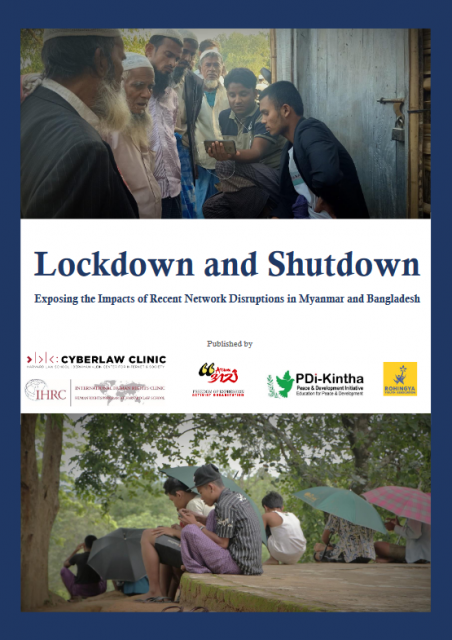Lockdown and Shutdown: Exposing the Impacts of Recent Network Disruptions in Myanmar and Bangladesh
The desperate situation of the Rohingya people has been routinely covered in the international news since the beginning of ethnic violence in Rakhine State in 2012, and particularly since the so-called “clearance operation,” conducted by Myanmar’s military, which pushed hundreds of thousands of Rohingya out of Myanmar and into Bangladesh in 2017. It is less well known, however, that in addition to other forms of persecution, deprivation, and indignity, Rohingya and other displaced ethnic minorities have faced historically long targeted internet shutdowns, both in Myanmar and in the world’s largest refugee camp in Bangladesh. In the current era, internet connectivity is necessary to meet many of the basic needs of life and core protected human rights: education, work, healthcare, free expression and access to reliable information. For displaced people and those in conflict situations, the internet can function as a literal lifeline, and for this vulnerable population, it is a lifeline that has all too often been cut off.
An internet shutdown is defined as “an intentional disruption of internet or electronic communications, rendering them inaccessible or effectively unusable, for a specific population or within a location, often to exert control over the flow of information.” Targeted internet shutdowns, like those ordered by the Myanmar government in Rakhine and Chin state, and by the Bangladesh government for Rohingya refugee camps near Cox’s Bazar, do not affect people in the aforementioned countries outside of the targeted areas, but they do further marginalize historically vulnerable communities.
For example, the over year-long and ongoing internet shutdown in Myanmar–one of the world’s longest running shutdowns–affects ethnic minority communities, namely Rakhine, Rohingya, and Chin internally displaced persons (“IDP”) residing in IDP camps and conflict-affected townships. Across the border, the 11 months long internet shutdown in Bangladesh affected more than 860, 000 Rohingya refugees. These shutdowns have been effective in cutting off communications and silencing voices from the targeted communities, but their deeper impacts have not, to date, been explored. Set against the backdrop of escalating armed conflict in Myanmar and COVID-19pandemic, this white paper examines the past and ongoing internet shutdowns in Myanmar and Bangladesh, highlighting their harmful impact on ethnic minority IDPs in Myanmar and Rohingya refugees in Bangladesh. Using sixteen semi-structured, qualitative interviews with Rakhine, Rohingya, and Chin IDPs and Rohingya refugees conducted over a one month period in August 2020, we seek to give voice to those who have been deprived of it, and reveal the devastating impacts that internet shutdowns have on their lives.
We begin the paper with overviews of the human rights situation in Myanmar and Bangladesh which lays the groundwork for both the rationale behind the internet shutdowns as well as their impacts. This section highlights the Tatmadaw’s 2017 “clearance operations”that forced more than 750,000 Rohingyas refugees to flee to Bangladesh, the ongoing armed conflict in Rakhine and Chin State in Myanmar and the situation in the Rohingya refugee camps in Bangladesh.We then move to examine the immediate causes of the targeted internet shutdowns in Myanmar and Bangladesh, which both began in 2019. Next, we demonstrate that violations of digital rights are violations of human rights, and explain why internet shutdowns impede the rights of IDPs and refugees. In Section 4, the heart of the white paper, we showcase the voices of our interviewees, and draw out key themes from the interviews. Our findings reveal that there are commonalities in the impacts of the shutdowns in both countries, such as in the areas of public health information around COVID-19, education, and access to reliable news in misinformation-rich environments, as well as differences in areas like work, access to healthcare, and physical security. The paper concludes with key recommendations to the governments of Myanmar and Bangladesh.


